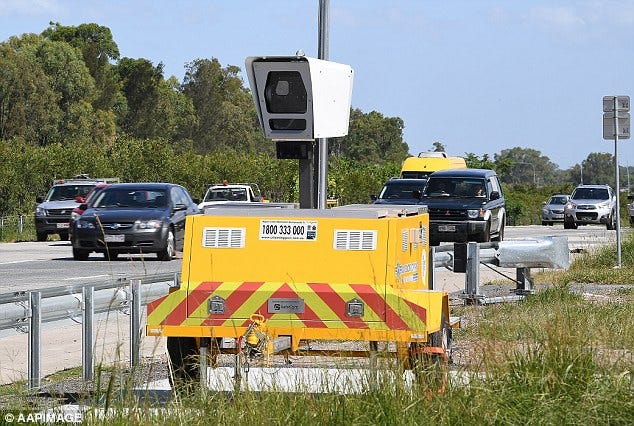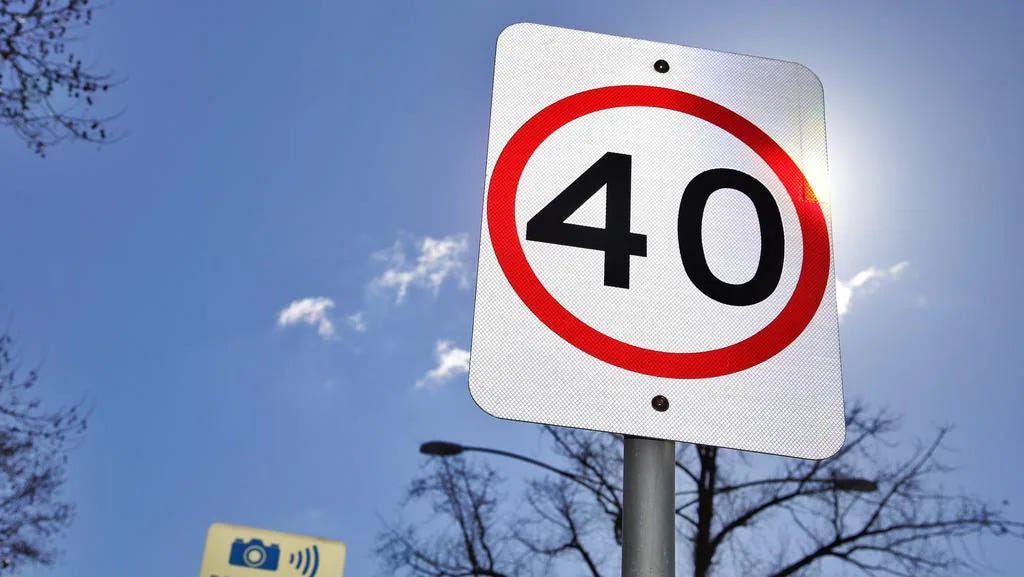Speeding fines are a significant source of revenue for state governments. In 2017, they amounted to more than $1.1 billion Australia wide and are probably higher now.
Speed cameras are a major contributor, particularly the mobile ones. In NSW, between July 2019 and February 2020, less than 18,900 fines worth $3.9 million were issued as a result of mobile speed cameras. Between July 2020 and February 2021, they were nearly 4.5 times that amount. Speeding ticket revenue for offences less than 10km/h over the limit increased from $2.3 million in 2019-2020 to $23.3 million in 2020-2021, coinciding with the government’s decision to remove speed camera warning signs.

Whereas speed limits were once advisory, with drivers expected to drive to the conditions, they now have the status of one of the ten commandments, with fines the price for sinning.
We are repeatedly told by ignorant police and bimbo journalists that road accidents are invariably due to excess speed. There are gory advertisements warning of lifelong injuries, with enforcement via fixed and hidden cameras, double demerits, average speed cameras, aerial monitoring, and highway patrols.
The underlying assumption never varies – below the speed limit is safe, above the limit is not.
Although the degree of correlation is disputed, there is a link between speed and the risk of accidents and injuries. Most people, libertarians included, accept that the roads are shared, and that individual freedom does not extend to harming others. The question is whether that means obeying speed limits.
The public does not necessarily think so. In the absence of visible enforcement or perceived hazards, voluntary compliance with speed limits is low. A 2009 survey found less than 20% of drivers claim to always drive at or under the speed limit. In NSW, of the 1.3 million speeding fines issued by cameras in 2021, 76 per cent were for exceeding the limit by under 10km/h. Outside narrow suburban streets, modestly exceeding the speed limit is rarely seen as a problem.

Australia has a National Road Safety Strategy, intended to provide a framework for prioritising the road safety activities of federal, state, territory and local governments. It is written by a small group of bureaucrats from each jurisdiction. Relevant ministers sign off on it but have minimal personal input.
For decades, the strategy has had a strong emphasis on speed accompanied by a coercive approach to enforcement. The 2010-2021 strategy, for example, argued for lower speed limits, increased penalties and enforcement that included in-car speed monitoring.
That changed somewhat in the 2021-2030 version. Although it has an objective of zero road deaths by 2050, there is less worshipping at the altar of speed limits. It also concedes that its past objectives have not been achieved. I suspect one of the key bureaucrats has retired.
If the aim is zero road deaths, and speed is the main causation, the obvious solution is to adopt very low speed limits. The problem is, that would be unacceptable to the community. There is an implicit assumption in current speed limits that a certain level of deaths and serious injuries is the price paid for convenient travel. The vision of zero road deaths is not only unobtainable, but irrational.
That raises an interesting question.
When the law says one thing and most people have a different view, which should prevail? And perhaps more to the point, should we have speed limits and,
if yes, who should set them?
Speed limits are currently set by anonymous, unaccountable bureaucrats. Perhaps the most powerful people in Australia, they have substantial influence over how many people should die on our roads. Governments and ministers come and go, but they and their speed limits are always there.

This is massive bureaucratic overreach. It is the public, not bureaucrats, who should determine the trade-off between travel convenience and the road toll. There is even an internationally recognised method of achieving this, known as the 85th percentile formula. Briefly, it involves the temporary removal of speed limits while speeds are monitored. At the conclusion of the period a limit is reimposed at or slightly above the speed at which 85 per cent of drivers travel.
The method is based on the assumption that the large majority of drivers are reasonable and prudent, do not want to crash, and wish to reach their destination in the shortest possible time.
Evidence shows that those who drive above or substantially below speed limits based on the 85th percentile are far more likely to cause accidents. Enforcement directed at those drivers has a positive impact on road safety and enjoys a high level of driver support.
If the public was to become concerned about any increase in road deaths or injuries, this can be expressed through periodic retesting of the 85th percentile.
If the government serves the people rather than vice versa, speed limits should have the approval of most drivers. And instead of being treated like sinful children and a source of revenue, motorists ought to decide what the limits are.
Thank you for your support. To help us in our battle to protect liberty and freedom please click here

David Leyonhjelm was an Australian Senator from 2014 to 2019 representing New South Wales for the Liberal Democratic Party. Notable for his libertarian consistency, David’s work in Senate Estimates attracted acclaim worldwide for its forensic examination of government
waste. Professionally, he is a veterinarian and agribusiness consultant.









